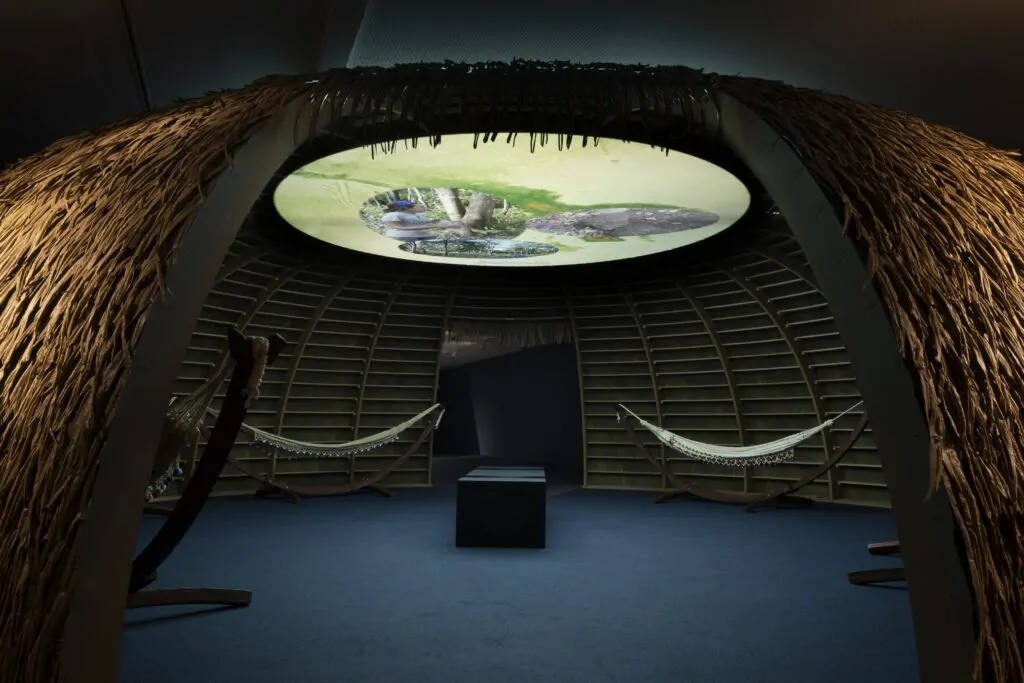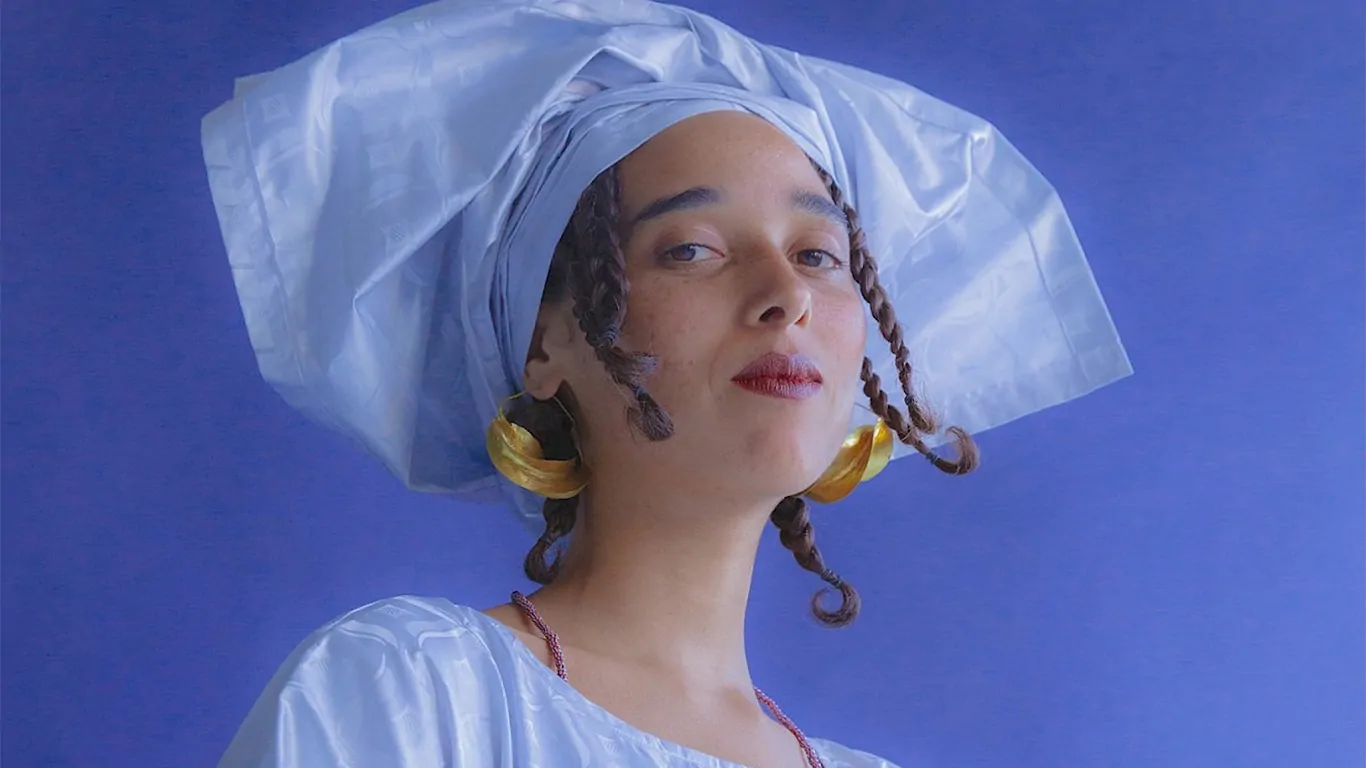Tabita Rezaire: Calabash Nebula
Curated by Chus Martínez
8th October, 2024 – 12th January, 2025
Museo Nacional Thyssen-Bornemisza
Madrid
Thyssen-Bornemisza Art Contemporary and the Museo Nacional Thyssen-Bornemisza present Tabita Rezaire. Calabash Nebula, the first solo show in Spain of the artist, devotee and cocoa farmer resident in French Guiana.
The immersive exhibition comprises three circular installations—two of them co-produced with Schering Stiftung in Berlin and Fondation Louis Vuitton—in which the artist examines the intersections between technology, land and spirituality.

Credit Marcella Ruiz Cruz
Composed with a sense of mystical wonder, her work exposes how (neo)colonial power structures continue to dominate our understanding of the cosmos. Through her works, she asks us to re-imagine and re-member ever-existing forms of resistance and cosmic travels.
Curated by Chus Martínez, the show will be on display from 8 October 2024 until 12 January 2025. The exhibition continues the line of work on post-colonial societies that TBA21 has been pursuing this year with the Museo Nacional Thyssen-Bornemisza.
Two clear examples of that joint project are the exhibition Colonial Memory in the Thyssen-Bornemisza Collections, in which works from the TBA21 Collection establish a dialogue with the Museum’s permanent collection, and the earlier TBA21 exhibition Search for Life by the Filipino-Canadian artist Stephanie Comilang.

Video installation (color, sound ) with wood, palm leaves, traditional Kali’na and Lokono handwoven cotton and palm leaf hammocks from French Guiana 61 min. Commissioned and co-produced by TBA21 Thyssen-Bornemisza Art Contemporary and Fondation Louis Vuitton with the support of the French Ministry of Culture, Youth and Sports (DCJS). Installation view: Tabita Rezaire. Calabash Nebula, 2024, Museo Nacional Thyssen-Bornemisza, Madrid. Photo: Roberto Ruiz, TBA21.
Calabash Nebula is a manifestation of her philosophy of life. The exhibition comprises three installations, two of which are dedicated to Yemoja, the orisha of the Yoruba people of West Africa and diaspora considered to be the mother spirit of rivers and oceans and all the creatures that live in them. “My work in general, and this piece in particular, revolves around the infinite, circular cycle of life,” she explains. The artist produced the three installations that make up Calabash Nebula in 2024: Omu Elu, commissioned by the Lagos Biennial (2024), Nigeria, courtesy of Tabita Rezaire and the
Goodman Gallery; Des/astres, commissioned and co-produced by TBA21.
Thyssen-Bornemisza Art Contemporary and Fondation Louis Vuitton, Paris, where the work will be presented in 2025 as part of the Open Space program; and OMI: Yemoja Temple, co-produced by TBA21 Thyssen-Bornemisza Art Contemporary and Schering Stiftung, Berlin, where the work was presented as part of the Omi Libations exhibition (April–July 2024). The three works function as a type of triptych that acts as a contemplation on the circle, a form with no end and no beginning.

Video installation (color, sound ) with wood, palm leaves, traditional Kali’na and Lokono handwoven cotton and palm leaf hammocks from French Guiana 61 min. Commissioned and co-produced by TBA21 Thyssen-Bornemisza Art Contemporary and Fondation Louis Vuitton with the support of the French Ministry of Culture, Youth and Sports (DCJS). Installation view: Tabita Rezaire. Calabash Nebula, 2024, Museo Nacional Thyssen-Bornemisza, Madrid. Photo: Roberto Ruiz, TBA21.
An immersive exhibition
Presented in an intimate atmosphere, the exhibition merges indigenous knowledge with modern science and invites us to reflect on the interaction between different thought systems and beliefs about science, the economy, and politics.

Six indigo-dyed textiles.
The production of this work was supported by IFN / Embassy of France in Nigeria and the Alliance Française, Lagos. Commissioned by Lagos Biennale, Nigeria, 2024. Courtesy Tabita Rezaire and Goodman Gallery.
Installation view: Tabita Rezaire. Calabash Nebula, 2024, Museo Nacional Thyssen-Bornemisza, Madrid. Photo: Roberto Ruiz, TBA21.
Visitors are welcomed by the circular installation Omu Elu (2024), composed of six textiles created by Rezaire that show different incarnations of the orisha Yemoja: as mother, water, creator, healer, ruler, and dancer. The cloths in the series are dyed indigo blue—the artist made them with her first indigo vat—highlighting Tabita’s commitment to the art of dyeing after working with traditional dyers in Nigeria. Her farm in French Guiana is also home to a garden of natural dyes.
The indigo pigment is used in numerous cultures to dye fabrics, decorate objects, make body ornaments, and carry out ritual healing practices. In the piece, indigo represents a tribute to the different shades of blue that symbolize Yemoja’s multi-faceted nature. With Omu Elu, Rezaire bridges the gap between cultural heritage and contemporary artistic practice, reinterpreting the sacred through a modern lens.

Six indigo-dyed textiles.
The production of this work was supported by IFN / Embassy of France in Nigeria and the Alliance Française, Lagos. Commissioned by Lagos Biennale, Nigeria, 2024. Courtesy Tabita Rezaire and Goodman Gallery. Installation view: Tabita Rezaire. Calabash Nebula, 2024, Museo Nacional Thyssen-Bornemisza, Madrid. Photo: Roberto Ruiz, TBA21. Installation view: Tabita Rezaire. Calabash Nebula, 2024, Museo Nacional Thyssen-Bornemisza, Madrid. Photo: Roberto Ruiz, TBA21.
The central piece of the show, exhibited for the very first time, is Des/Astres (2024), a commission by TBA21 and Fondation Louis Vuitton with support from the French Culture, Youth and Sport Ministry. The architecture of the installation—circular wood with a palm leaf roof—evokes a carbet, a traditional place of gathering, celebration, and exchange of French Guiana. A circular video is projected on the underside of the roof, like a digital sky, creating an immersive experience similar to that of a planetarium. Reclining on traditional hand-woven Amerindian hammocks made of cotton and palm leaves, visitors are invited to interact with the piece.
The audiovisual is divided into four sections (forest, water, stone, and sky) and explores humans’ connection with the cosmos. Images of the Amazon rainforest with its sacred trees are juxtaposed with interviews with scientists, researchers, and guardians of traditions who reflect on their visions of the universe. Merging scientific research with sacred traditions, the installation encourages thoughtful consideration of historical and contemporary perception of the cosmos. Des/astres reveals a rich tapestry of knowledge that encompasses archaeology, cosmology, and astronomy.

Installation with sound and indigo-dyed cotton fabric, wood, zip ties, calabashes, ceramics, cowrie shells, water, honey, coconut flakes, indigo vat. Co-produced by TBA21 Thyssen-Bornemisza Art Contemporary and Schering Stiftung, Berlin, where the work was presented as part of the exhibition “Omi Libations” (April 25– July 7, 2024). Installation view: Tabita Rezaire. Calabash Nebula, 2024, Museo Nacional Thyssen-Bornemisza, Madrid. Photo: Roberto Ruiz, TBA21.
The third piece of the exhibition Calabash Nebula is the installation OMI: Yemoja Temple, a shrine dedicated to Yemoja. The work, which explores the intersection between biology and spirituality, revolves around water as the source of life. It is a co-production by the German foundation Shering Stiftung and TBA21. The conceptual basis for the piece is a research trip to Tanzania which Rezaire made with the artist-architect Yussef Agbo-Ola and the biologists Alex Jordan and Anja Wegner of the Max Planck Institute of Animal Behaviour to study the flora and fauna of coral reefs and the ecosystem of Lake Tanganyika.
The result is a temple designed in the shape of a drop of water that invites visitors to connect with an environment inhabited by physical and spiritual beings through a textile surface dyed blue and an immersive sound installation. In this space of connection and quiet contemplation, visitors can make libations with water, honey, and indigo. The confluence of biology, ecology, spirituality, and architecture offers new perspectives on aquatic dimensions and the origin of life.
The pieces in Calabash Nebula submerge visitors in a profound exploration of aquatic ecosystems and indigenous worldviews while encouraging critical consideration of contemporary realities and environmental challenges. They are a call to reconnect with the environment and acknowledge the wisdom of non-western cultures in the search for solutions to the global ecological crisis.

Installation with sound and indigo-dyed cotton fabric, wood, zip ties, calabashes, ceramics, cowrie shells, water, honey, coconut flakes, indigo vat.
Co-produced by TBA21 Thyssen-Bornemisza Art Contemporary and Schering Stiftung, Berlin, where the work was presented as part of the exhibition “Omi Libations” (April 25– July 7, 2024 ).
Installation view: Tabita Rezaire. Calabash Nebula, 2024, Museo Nacional Thyssen-Bornemisza, Madrid. Photo: Roberto Ruiz, TBA21.
Public Program
Calabash Nebula is accompanied by a broad program of activity, all free of charge, which includes talks, encounters, and workshops designed to offer visitors the opportunity to engage more meaningfully with the skies, bodies of water, and ancestral traditions. It includes in-person and online lectures by experts in different fields, such as astronomy, art, and Afro-descendant culture.
On 10 December, the Auditorium at the Museo Thyssen-Bornemisza will be the setting for a proposal that explores the intersection between art and technology. María Arnal, whose artistic practice is deeply influenced by technological advances, will give a dramatic reading and then converse with the computing expert Fernando Cucchietti.
The program also includes activities for children, such as the Create Your Own Constellation workshop that will take place once a month at the Royal Observatory of Madrid; and during science week, workshops, tours, and conversations for young people will be organized in the exhibition hall and at the Royal Observatory. In addition, La Parcería and, on Saturday nights, Madrid Negro will lead themed tours of the exhibition.
The show is also accompanied by a digital publication with texts by the curator Chus Martínez and Omikunmi Egbelade, Tabita Rezaire, and Joël Vacheron.
Tabita Rezaire. Calabash Nebula presents three new works by the artist produced in 2024: OMI: Yemoja Temple, co-produced by TBA21 Thyssen-Bornemisza Art Contemporary and Schering Stiftung, Berlin, where the work was presented as part of the Omi Libations exhibition (April–July 2024); Des/astres, commissioned and co-produced by TBA21 Thyssen-Bornemisza Art Contemporary and Fondation Louis Vuitton, Paris, where it will be presented in 2025 as part of the Open Space program; and Omu Elu, commissioned by the Lagos Biennial (2024), Nigeria, courtesy of Tabita Rezaire and the Goodman Gallery.
The public program for the Tabita Rezaire. Calabash Nebula exhibition has the generous support of the Institut Français in Spain, the Royal Observatory of Madrid, the Spanish Foundation for Science and Technology (FECYT), and the Barcelona Supercomputing Center (BSC). It is organized in association with Educathyssen and Organismo.
Tabita Rezaire: Calabash Nebula, Curated by Chus Martínez opens on the 8th of October, 2024 until the 12th of January, 2025 at Museo Nacional Thyssen-Bornemisza, Madrid
©2024 Thyssen-Bornemisza Art Contemporary





